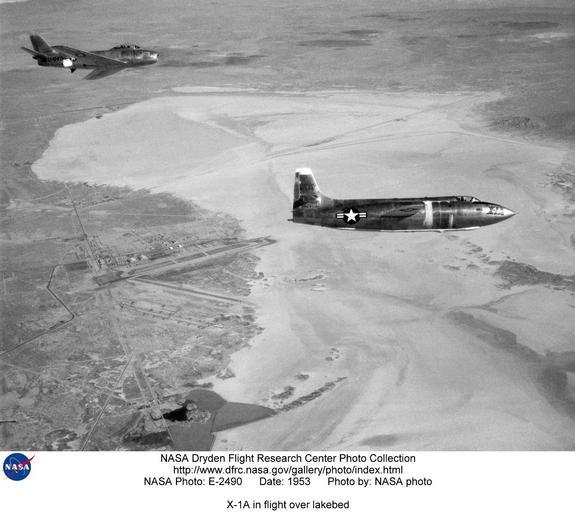MAKE A MEME
View Large Image

| View Original: | X-1A_in_flight_over_lakebed_DVIDS739014.jpg (1536x1367) | |||
| Download: | Original | Medium | Small | Thumb |
| Courtesy of: | commons.wikimedia.org | More Like This | ||
| Keywords: X-1A in flight over lakebed DVIDS739014.jpg en The Bell Aircraft Corporation X-1A 48-1384 returning from an Air Force test flight over Edwards Air Force Base California in late 1953 A North American F-86A Sabre as chase plane will follow the X-1A to touchdown The Rogers Dry Lake is the whitish area under the planes with the airfield at the edge of the dry lake Bell test pilot Jean Skip Ziegler made six flights between 14 February and 25 April 1953 Air Force test pilots Maj Charles Chuck Yeager and Maj Arthur Kit Murray made 18 test flights between 21 November 1953 and 26 August 1954 NACA test pilot Joseph Walker made one successful flight on 20 July 1955 During a second flight attempt on 8 August 1955 an explosion damaged the aircraft shortly before launch Walker unhurt climbed up into the JTB-29A mothership and the X-1A was jettisoned over the Edwards AFB bombing range There were five versions of the Bell X-1 rocket-powered research aircraft that flew at the NACA High-Speed Flight Research Station Edwards California The bullet-shaped X-1 aircraft were built by Bell Aircraft Corporation Buffalo N Y for the U S Army Air Forces after 1947 U S Air Force and the National Advisory Committee for Aeronautics NACA The X-1 Program was originally designated the XS-1 for EXperimental Sonic The X-1's mission was to investigate the transonic speed range speeds from just below to just above the speed of sound and if possible to break the sound barrier Three different X-1s were built and designated X-1-1 X-1-2 later modified to become the X-1E and X-1-3 The basic X-1 aircraft were flown by a large number of different pilots from 1946 to 1951 The X-1 Program not only proved that humans could go beyond the speed of sound it reinforced the understanding that technological barriers could be overcome The X-1s pioneered many structural and aerodynamic advances including extremely thin yet extremely strong wing sections; supersonic fuselage configurations; control system requirements; powerplant compatibility; and cockpit environments The X-1 aircraft were the first transonic-capable aircraft to use an all-moving stabilizer The flights of the X-1s opened up a new era in aviation The first X-1 was air-launched unpowered from a Boeing B-29 Superfortress on Jan 25 1946 Powered flights began in December 1946 On Oct 14 1947 the X-1-1 piloted by Air Force Captain Charles Chuck Yeager became the first aircraft to exceed the speed of sound reaching about 700 miles per hour Mach 1 06 and an altitude of 43 000 feet The number 2 X-1 was modified and redesignated the X-1E The modifications included adding a conventional canopy an ejection seat a low-pressure fuel system of increased capacity and a thinner high-speed wing The X-1E was used to obtain in-flight data at twice the speed of sound with particular emphasis placed on investigating the improvements achieved with the high-speed wing These wings made by Stanley Aircraft were only 3 3/8-inches thick at the root and had 343 gauges installed in them to measure structural loads and aerodynamic heating The X-1E used its rocket engine to power it up to a speed of 1 471 miles per hour Mach 2 24 and to an altitude of 73 000 feet Like the X-1 it was air-launched The X-1 aircraft were almost 31 feet long and had a wingspan of 28 feet The X-1 was built of conventional aluminum stressed-skin construction to extremely high structural standards The X-1E was also 31 feet long but had a wingspan of only 22 feet 10 inches It was powered by a Reaction Motors Inc XLR-8-RM-5 four-chamber rocket engine As did all X-1 rocket engines the LR-8-RM-5 engine did not have throttle capability but instead depended on ignition of any one chamber or group of chambers to vary speed The X-1A X-1B and the X-1D were growth versions of the X-1 They were almost five feet longer almost 2 500 pounds heavier and had conventional canopies The X-1A and X-1B were modified to have ejection seats Their mission was to continue the X-1 studies at higher speeds and altitudes The X-1A began this research after the X-1D was destroyed in an explosion on a captive flight before it made any research flights On Dec 12 1953 Major Charles Yeager flew the X-1A up to a speed of 1 612 miles per hour almost two-and-a-half times the speed of sound Then on Aug 26 1954 Major Arthur Murray took the X-1A up to an altitude of 90 440 feet Those two performances were the records for the X-1 program Later the X-1A was also destroyed after being jettisoned from the carrier aircraft because of an explosion The X-1B was fitted with 300 thermocouples for exploratory aerodynamic heating tests installed on it It also was the first aircraft to fly with a reaction control system a prototype of the system used on the X-15 The X-1C was cancelled before production All three of the Bell Aircraft Company-manufactured planes had 6 000-pound-thrust XLR-11 four-chambered rocket engines The XLR-11 was built by Reaction Motors Inc The aircraft were all air-launched from a carrier aircraft NASA Identifier NIX-E-2490 2009-09-23 Glenn Research Center https //www dvidshub net/image/739014 739014 2012-10-18 00 30 WASHINGTON DC US PD-USGov Aircraft at Rogers Dry Lake Images from DoD uploaded by Fæ Bell X-1 North American F-86 Sabre | ||||